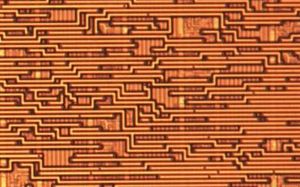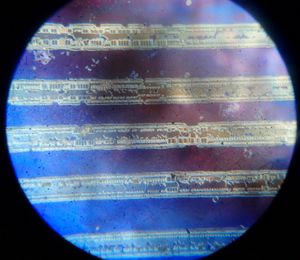Difference between revisions of "Main Page"
| Line 118: | Line 118: | ||
Properly adjusted can give a real improvement in image quality. Unadjusted (Mit20x objejective): | Properly adjusted can give a real improvement in image quality. Unadjusted (Mit20x objejective): | ||
| − | [[File: | + | [[File:as_fs_unadj_mit20x.jpg|300 px]] |
Adjusted (Mit20x objejective): | Adjusted (Mit20x objejective): | ||
| − | [[File: | + | [[File:as_fs_adj_mit20x.jpg|300 px]] |
| Line 150: | Line 150: | ||
Polarized light can bring out a lot of interesting effects and help reduce glare. However, if you don't use strain free objectives you will get effects like this: | Polarized light can bring out a lot of interesting effects and help reduce glare. However, if you don't use strain free objectives you will get effects like this: | ||
| − | [[File: | + | [[File:bad_objective_polarization.jpg|300 px]] |
Revision as of 13:00, 26 December 2018
Since microscopes are a critical instrument this section provides information on both microscope techniques and equipment. There are already many good sites on microscope techniques so the focus will be more on discussing which ones are relevant for ICs and providing external links to provide more information.
Contents
General reccomendations (optical)
Base microscope
TLDR:
- Usually a surplus high quality microscope will cost less and provide better results than a new entry level microscope
- Objectives drive most of the quality
- Olympus BH is a good surplus option if you need basic brightfield and/or darkfield imaging
- Olympus BH2 is a good option if you need more advanced features, but will cost a lot more
- K2-IND is a good confocal option
- Only use long working distance (LWD) objectives if you need them
- They are expensive
- They have lower resolution
- Oil objectives (almost contacting sample) will have the highest NA (say 1.4) => resolution
- Probe station
- B&L industrial objectives is a good low cost option
- Mitutoyo FS50 or FS60 is a good higher end option
- Can add NWR ezlaze for laser probe station
When I first started seriously looking for equipment (Say around 2010) the Olympus BH / BH2 were pretty good options, with a complete BH costing maybe $300 and the BH2 costing maybe $600. I've heard the market has dried up a bit, but they still may be decent options. Note the BH is a 210 mm finite system while the BH2 uses infinity optics. Therefore, you should not mix parts from the two or image quality will suffer.
A lot of people go with AmScope but usually regret it after comparing with other microscopes. However, the objectives drive most of the image quality. So consider replacing them with higher quality objectives. Make sure you match optical parameters (ex: use objectives that also use 160 mm tube length).
Automation (ie CNC)
Summary
- Calculate your actual needed resolution
- Don't buy over precise stages. Moving between images will take unnecessarily long
- Stepper motors: use microstepping to reduce vibration
- I've had good results with machinekit (LinuxCNC) running stepper motors
- uManager / ImageJ can be a good solution, supporting misc commercial microscope stages
Surplus stages designated for microscopes may cost $1000. However, if you have some basic machining skills, you should be able to hobble something together using other surplus stages. Generally steppers are easiest to drive.
Ideally your stage should be sufficient positioning resolution small relative to your image size. For example, if you have a 500 um FOV at highest resolution (100x), maybe get stages that can do at least 50 um steps. My stages can do something like 10 nm steps, which are simply overkill and just leads to overly long movement times. 1% tolerance at max FOV may be a good target.
Some non-CNC microscope chassis may be easier to mod for CNC control. For example, the Olympus BHMJ is a boom mount, which can be easy to re-mount with a stage.
Camera
Things to consider:
- What resolution do you need? Likely your lowest magnitude objective will drive this
- Consider how camera RGB pattern will effect resolution
- I use 4x resolution to compensate
- How many bits do you need? Most cameras are 8 bit, but 12 or 16 bit will provide better dynamic range
- Do you have low light requirements? Otherwise you probably don't need a cooled camera
For Linux software, as of Nov 2017, I believe the MU800 is the only camera with V4L support in Linux (also noting there are MU300 and MD1900 drivers not in mainline). AmScope/TopuTek/ScopeTek does provide libusb drivers though, so you could make a custom application. Finally, note uManager supports misc microscope stages out of box.
Some people elect to use DSLRs. You can control these using gPhoto2 or similar solutions.
McMaster reference system
My standard system is something like:
- Olympus BH2 core w/ BH2-UMA
- Chassis
- Don't have a consistent option here
- Post mounted (ex: BH2 BHMJ) is easy to use
- The large frame used on pr0nscope is relatively popular, but I don't know model number
- Surplus linear stages
- Retrofitted with MDrive17 integrated driver stepper motors
- Machined mounts
- Mirror mount for leveling
- Full size: large mount (ex: Newport NRC 39) rightside up
- Small / low cost: small mount (ex: Newport MM2) upside down
- Machinekit on beagle bone black (BBB) as CNC controller
- Usually with an Adafruit 572 (Proto Cape Kit for BeagleBone & Beagle Bone Black) for connectors and/or level translation
- Thinkpad T61p controlling the microscope
- MU800 microscope camera
- Modified v4l Linux driver for the MU800
- For direct RGB control
- pr0ntools (libpano core) for image stitching
Specific system information here]]
SEM
TLDR:
- Good entry level option (~30 nm): RJ Lee PSEM
- Good entry level option (~7 - 30 nm): a recently maintained ISI SEM
- Modern higher resolution (< 10 nm): expect to pay at least 7k (as of 2017)
A good entry level SEM is the RJ Lee PSEM. They are relatively compact and list for about $2-3k on eBay. For example, my PSEM cost about $2000, including shipping, to get operational. However, the instrument is relatively limited, providing an estimated resolution of only about 30 nm. The Super IIIA, for comparison, has a resolution of about 7 nm. This means a hit of about 18x as much information with a 2D image.
ISI SEMs can be found surplus but, mostly due to their age, can be hit or miss. A friend recently (as of Nov 2017) found not one, but two ISI DS130 SEMS free on Berkeley Craigslist. The first one was still in service and he was able to get it running no problem...after hiring riggers to move it. Mainly, if you know the SEM was still maintained and in operation until recently, it will probably be fine. If its fallen out of use for a long time, you will have to do a pretty serious overall, replacing o-rings and such. Ultimately I scrapped my Super IIIA because I was unable to fix a column vacuum leak (ie inaccessible o-ring without damaging the column, party due to old plastic)
Camera
Point and shoot cameras seem to work best as their apertures are better matched to the eyepieces found on microscopes. Some older microscopes, such as a Unitron N series, that were built to work with Polaroid style cameras might adapt to larger professional style lenses with appropriate modifications.
Jury-rigged eyepeice cameras
If your camera has a zoom setting, make sure to use it to get rid of the eyepiece ring.
Microscope
A biological microscope works well enough for some initial tests on older technology. However, you will likely need something more advanced such as a confocal microscope or metallurgical microscope. If you have access to a SEM/TEM, those will likely have imaging equipment already built into them to capture digital images.
There seems to be no inherent difference in objectives between a metallurgical and a compound biological microscope. However, there are a number of fine points if you are trying to get a good image. An objective's threading and microscope's focusing system can also differ. See the following:
Infinity optical systems: [1] Objective specifications: [2]
Leveling images
Make sure the stage is very level with respect to the lens. This can be checked by moving the die from one side to another. You will also notice images that are in focus on one side and out of focus on the other. Levelling mechanisms:
- Kinematic or other precision mechanical device
- Glass on clay or other soft material. Apply pressure to vary angle
Stitching
Follow the Hugin tutorial for stitching scanner images]. If you have an XY stage, you can take out the rotation parameter since it should be negligible.]
Field Stop (FS) and Aperature Stop (FS)
Properly adjusted can give a real improvement in image quality. Unadjusted (Mit20x objejective):
Adjusted (Mit20x objejective):
DIY non-optical
Type
Epi-illumination: the most common type used in IC RE. A typical setup has a side lamp that hits a half silvered mirror between the objective and the eyepiece. Light hits the mirror to reflect towards the sample and bounces back. Half of that light reaches the eyepieces and that is the image you observe. This can produce thin film interference patterns to distinguish even same color specimens.
Biological: the most common type of microscope most people encounter. A typical setup has a lamp in the base that shines light through a condenser that focuses light through a sample and into the objective and then into the eyepiece. Since most IC samples are opaque this type of microscope is not suitable for IC work. However, as a move of desperation, you can use one by shining light from the side. This is how I did my early IC work. Things are much better if you can get a hold of a fiber illuminator, but chances are if you can afford a fiber illuminator you can afford a cheap epi-illumination microscope.
Confocal]: can produce 3-D images. Desirable as an upgrade from an epi-illumination microscope but costs much more]
electron microscope (SEM)]: useful for high resolution images. High resolution than optical microscopes but not at atomic scale. Images have both large depth of field and resolution. Main local wiki article: sem_start SEM]
Transmission electron microscope (TEM)]: useful for very high resolution images at the atomic scale.]
Inverted: a microscope designed to look at a sample from below as opposed to above. There are both biological (for culture observation) and metallurgical versions. I find these inconvenient to use and don't recommend it.
Polarized light
Polarized light can bring out a lot of interesting effects and help reduce glare. However, if you don't use strain free objectives you will get effects like this:


